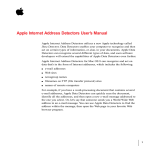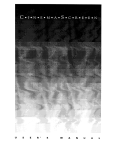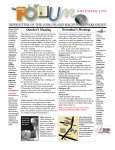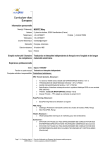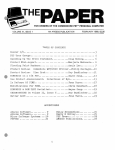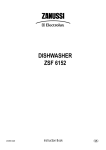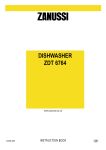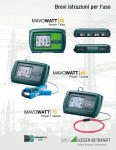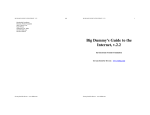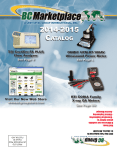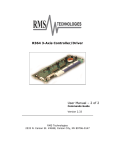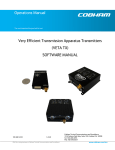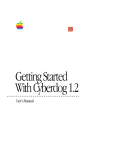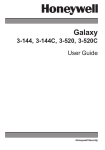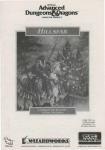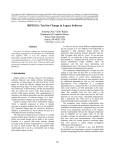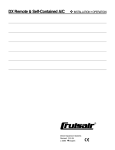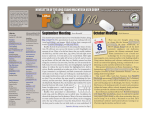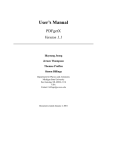Download TIP! - Long Island Mac Users Group
Transcript
The LIMac O C T O B E R 19 9 6 NEWSLETTER OF THE LONG ISLAND MACINTOSH USERS GROUP LIMac has been serving Macintosh users on Long Island since 1984, when the Mac was introduced. Annual dues for membership is $24. First meeting is free. For information, you can contact any of the following: Membership Alan Gordon (516) 538-7013 [email protected] Public Domain Software Helen and Sheldon Gross (212) 799-5655 [email protected]. cybernex.net Technical Advice Bradley Dichter (516) 874-4363 [email protected] Program Coordinator Rick Matteson (516) 379-0174 [email protected] Beginners SIG Sy Bram (516) 378-9076 [email protected] DTP SIG Balan Nagraj (516) 427-0952 [email protected] ED SIG Rick Matteson (516) 379-0174 [email protected] Internet SIG Al Choy [email protected] Internet Address http://www.limac.org September’s Meeting: Olympic Olympus The prices of CD Recorders discussed the features of this and other magneto-optical product. There was an drives have become very interesting exchange of views attractive. How good are with members on how this they and what are the benefits device compares with the of these devices? To cover Syquest and Zip drives. this subject, LIMac’s featured Olympus has priced the “How good are they and what are media on this device at about speaker was Michael Rubin, the benefits of these devices?“ CD-Recorders Product $10, which is very attractive. Manager of Olympus Image Michael’s presentation Systems. was informative and well received. He also had Starting with a brief background about his some special prices for LIMac members: A company, whose U.S. headquarters are in refurbished CD-R2/MAC for $500 and a new Melville, Michael discussed their line of storage CD-R2x4 recorder for $775. These prices are products and the recently introduced digital valid for a short time. Please call him at (800) cameras. He demonstrated their CD-R2x4 with 347-4027, extension 5312, if you are interested. the Corel CD Creator application package. He | On this night, we also had our first mentioned that Olympus has opted to go with meeting of the Internet SIG. Al Choy, our the Corel product over the more popular Toast coordinator for this SIG, did a commendable Pro, because of better technical support. He job of explaining the basics of surfing the web. covered the requirements for creating a CD like LIMac is actively looking at a couple of meeting a good software package, a non-fragmented places, where we can go online for this SIG large hard drive, etc. The data has to flow meeting. continuously without interruption. He | Raffle winners: Bill Sympson (Adobe’s mentioned that the SCSI chain on some of the Sitemill and IDG Books’ Macworld Home older Macs are not fast enough to handle the Office Companion); Frank Silverman (ASDG’s speed required for recording a CD. Elastic Reality); Jim Tornatore (CB Software’s Olympus made quite a hit at the Boston Web Arranger). MacWorld with their SYS.230, a portable –Balan Nagraj l 230MB magneto-optical drive. Michael October’s Meetings: General Meeting: Friday, Oct. 11, 7:00 P.M. Fractal Design’s Detailer, a 3D painting program, and Poser, a human figure design program. DTP SIG: Fractal Design’s Painter 4, and Expressions, a natural media vector drawing program. Ed SIG: Friday, October. 11, 9:00 P.M. Educational CD-ROM demonstrations: Come gather ‘round Geoff’s Performa 5300 and Rick’s borrowed LC 580 (on loan from the Copiague Middle School) and get real world demo of some of the best educational software available on CD-ROM. Beginners SIG: Friday, Oct. 18, 7:00 P.M. Review Macintosh basics, discuss hard disk organization, and, most importantly, take 3 months worth of beginners questions. LIMac Meetings, unless otherwise noted, are held at the NY Institute of Technology (Building. 500), at Northern Blvd., Old Westbury. To see if school is open in bad weather, call (516) 686-7789. The next LIMac board meeting will be held at the Plainedge Library on Monday, October 21, 1996. Dues collection for 1997 begin this month. Our dues remain at the reasonable $24 level because of the support that you have shown to LIMac.Bring your checks to the next meeting or mail them to: Alan Gordon, LIMac Membership, 472 Linda Drive, East Meadow NY 11554 LIMac Inc. P.O.Box 518 Seaford,NY 11783 President Balan Nagraj [email protected] Vice President Bill Medlow [email protected] Treasurer Donald Hennessy [email protected] Secretary Wallace Lepkin [email protected] The LIMac Forum Editors/Graphics Mo Lebowitz Loretta Lebowitz [email protected] Distribution Wallace Lepkin Donald Hennessy Printing Willow Graphics (516) 785.5378 Imagesetting A&B Graphics (516) 433.8228 The FORUM is published monthly by LlMac.All contents, except where noted, are copyright ©1996 by LIMac.Opinions expressed are the views of the authors and do not necessarily reflect those of LIMac.Contents may be reprinted for noncommercial use, with due acknowledgment to LIMac. Game Corner: Terminal Velocity. A review by Dan Gross Age 14. A high flying, fast, action-packed game. You’re flying a TV-202, a fighter that only a few elite pilots can handle. Considering that the previous model, the TV- 2 Balan Nagraj President [email protected] Game Corner.1 Diamonds 2.02: A Review by Todd Medlow Diamonds 2.02 is a wonderful game for the creative mind.It turned many heads as it made its way to the top to become Macworld’s 1993 Arcade Game of the Year.Several years later, Mac Soft created Diamonds 3D, a sequel to the original.Its 3rd dimension depth brings a new feel to the Diamonds family. Depth allows you more freedom, and surprises around many corners.To complete each level, you must hit bricks in the distance down a square tunnel with your ball.Unfortunately, this masterpiece does not come with a level editor. – Todd Medlow 101, has led to more pilots’deaths than any other plane, you feel very lucky to be alive.That’s probably about to change since, it’s you against the defense system of the entire universe that is out to destroy humanity.You have been training all of your life to fly this ship, but are you ready for a challenge as big as this? “You’re outgunned, out-manned, and strapped into a flying coffin.But just think how good “Saved the Known Galaxy”will look on a resume…” Taking control of your TV-202 is fairly easy and can be mastered using the keyboard, the mouse, or a joystick.The ship handles easily and makes quick, sharp, and deadly turns.The radar is a very simple device, but necessary to find and destroy enemy bases.The cockpit controls make traveling in your ship much simpler because you always know where to go and what condition your ship is.You start out with only a plasma gun but quickly build up an arsenal of seven different weapons, each one bigger and stronger than the last.Also you can find powerups to boost your shields and increase your speed and weaponry. The music is of very high quality and fits right in with the action.Sound effects are great, from the explosion of the enemy aircraft against the surface to the rapid fire of your laser cannon.The graphics are very detailed with fast scrolling action.Its very great response rate President’s Remarks Conflict Catcher 3 A few days after the presidential elections, we hold LIMac’s elections for our officers and directors, as outlined elsewhere. Since most schools are closed on election day, a free session in the Big Apple provides an excellent opportunity for teachers to learn about the latest developments in publishing and media technologies. There will be free conference at the Fashion Institute of Technology in New York City on this day (November 11, 1996). Following is an excerpt from an article, written by Jack Powers, a recognized authority on publishing, that appears in the MICRO PUBLISHING NEWS of September 1996. “Executives working in the printing and publishing industry spend a substantial part of their time keeping up to date, but the teachers only get one day a year to find out what their kids will need to know about desktop publishing, computer graphics, digital imaging, graphics, multimedia, CD-ROMs, and the Internet. In six hours each November, we try to pack in every relevant innovation, product, process, and perspective so that the educators can give their students the skills they’ll need when they graduate in the next century. “It’s a completely free conference open to any junior high school and high school teacher in the New York metropolitan area. Volunteers from the industry put together the program, organize the event and present the seminars. The folks at Pantone always help out, and New York area experts like GATF consultant Howie Fenton and AGC president Bill Dirzulaitis donate their time and talent. “What should the teachers be teaching? Keeping in mind that this month’s new ninthgraders will graduate high school in June of 2000 and finish college in 2004. what skills will they need, what technologies should they learn, to find careers in the publishing and printing fields? Look back at the changes that have happened since 1989, and you can see how hard it is to visualize the future. … “For more information about the Graphic Arts Teachers Technology Conference, contact Jack Powers at (718) 499-1884, e-mail [email protected] or visit the Web page at www.electric-pages.com/GATCC.” l I almost made this a non-review by simply writing: Conflict Catcher 3? Get it! End of review. But that would not be very fair either to Casady & Greene who would like to see a review nor to you, the reader, who would want to know why. There are very few pieces of software that I would say need to be an integral part of your system. If you have a Performa and do not intend to upgrade or add any software to your system, (in other words, you intend to keep it just like when you purchased it) then you do not need Conflict Catcher. However, for the rest of us, especially those of us who run extension-heavy machines, Conflict Catcher 3 is the number one piece of software I would personally recommend that you get and add to your system. Why? After all, System 7.5 comes with Extensions Manager. True, but if you run into an extension conflict, it can take hours (or days) to find. With Conflict Catcher 3(CC3) the time spent solving the problem is much less. I ran a test with the System 7.5.1 upgrade using both Conflict Catcher 3 and Extensions Manager. With Conflict Catcher 3 it took 25 minutes to find the conflict; with Extensions Manger I stopped after one hour (and I still had not found it!). I had Conflict Catcher 2 and it was a wonderful program. It did everything you expected of it and then some. Casady & Greene could have left it alone; continued to market it and sold the improvements as a secondary program for Conflict Catcher 2. Instead they did a very honorable thing. They decided to sell it as an upgrade and, unlike most upgrades these days, it is truly worthy of the term! Conflict Catcher 3 makes its predecessor look like a porker! It is faster, and runs in a more logical manner making it much more efficient. As more and more hardware and software comes out, more extensions, files, etc. are added to your system folder. You add the product of the week: a new printer, a new modem, the newest upgrade of your system software or finally that one piece of software/ hardware you’ve been lusting for since the day you got your machine and BANG! the system freezes, crashes, doesn’t work. What happened? Briefly what happens is this: Your system THE LIMAC FORUM/OCTOBER 1996 TIP! Solving Problems With Your HP DeskJet or Desk Writer 500: Remove the print cartridge.Use a soft cloth,slightly dampened with water,to clean accumulated paper dust and ink from the metal platen,cartridge guide and paper feed rollers.(Check your user manual if you’re uncertain which is which.) Look at the print cartridge to make sure the protective tape shipped on it has been removed from the nozzle and vent. Use a damp cloth to clean the print cartridge cradle and the contacts on the print cartridge.Place the cartridge back into the printer, making sure you install it correctly. Now,press the Clean button. If the above steps haven’t taken care of your printing problems,it may be time to replace the print cartridge. – from (The Circle) Laser Update keeps the game moving, no matter what. To make a great game even better, Terminal Velocity can be played over the World Wide Web against other pilots to see who really is the best pilot.Also you can use Remote Ridicule to send taunts and comments to your opponents and teammates.With no limits to the number of fighters there are, the game can go crazy in a matter of minutes.I had a great time with this game. ? What’s in your System Folder? Software FPU. This Control Panel attempts to replace the missing math coprocessor with a software emulation of one.The low cost Quadra and LC models and others, did not have one and some software required the Floating Point Unit.The Power Mac ’s current software emulation does not include an emulated FPU, so this Control Panel can help there too. Sound Master. A frivolous Control Panel that can play a selected sound file at the desired event, such as a disk insertion or the trash can being emptied. Magic Menu. This Control Panel is an extension to Aladdin ’s Stuffit Deluxe which adds a new menu to the Finder.It makes it easier to compress and decompress files right in the Finder, without having to use the application directly. StuffIt SpaceSaver. This Control Panel uses the Stuffit Deluxe system to automatically compress all the old files on your hard drive, to better conserve space.You can change a file’s name and have it automatically compress or decompress.–Bradley I have included a few codes for your convenience while playing the game.Just type in the following codes while in the game: TRIFIR0 - Temporary invincibility TRFRAME - FPS ticker TRIBURN - Speeds after burner up TRIFIR1 - PAC ammo MANIACS - 1000 After burner ammo RIFIR2 - ION ammo TRIHOVR - Hover while firing TRIFIR3 - RTL ammo TRIGODS - Invincibility TRIFIR4 - MAM ammo 3DREALM - Power up all weapons TRIFIR5 - SAD ammo TRINEXT - Skip to next level TRIFIR6 - SWT ammo TRISHLD - Shield restore TRIFIR7 - DAM ammo TRSCOPE - Oscilloscope TRIFIR8 - 200 After burner ammo TRIFIR9 - temporary invisibility TRWARP*- Warp to level * (Only from v1.1 and upwards) Please e-mail any comments [email protected]. l 3 More Conflict Catcher 3 runs on software. Unfortunately, so does all other hardware. All the hardware and software that you use relies on extensions and/or other start-up files. That is where an extension management program comes in. While System 7.5 comes with Extension Manager, it is only good as long as everything behaves. Hey – let’s get real. This is a computer we’re talking about. Because of that unfortunate little fact, extension conflicts are inevitable. Some can be resolved easily – just switch the reload order; others may be harder to determine due to damage, multiple extensions trying to load simultaneously, bad programming code, or other incompatibilities. It really does not matter since you still have to find out what is giving you the problem. That’s the beauty of Conflict Catcher 3. For instance: when you start the Conflict Catcher process, it gives you a chance to help it by targeting files you think may be the culprits with its Intuition feature This can save lots of time in your conflict search. Then the program turns off the last control panels and extensions that you installed and scans for damaged resources in your start-up files. You can also display your start-up files in several different list views including Date Installed, whether or not the file is Enabled, Folder, Kind, Load Order (my personal favorite), amount of Memory Used or Name, and you can display just about everything in the CC3 window in addition to your extensions and control panels including your fonts, start-up items and shut-down items as well as your Apple Menu. CC3 also keeps a log of your tests so that you can review them. The System Report feature gives you System Information, Hardware Information, Driver Information, Start-Up File Information, Conflict Catcher Preferences and Patched System Traps so those of us who are curious can actually get under the skin of the Mac O ⁄ S! By clicking on the individual file’s name, you can get a CC3 version of the Get Info window. You can also give your files individual color codes so that you can see exactly what you are looking at with a glance, using one color for fonts, another for extensions, etc. The Link feature is very helpful, letting you create linked groups of extensions in various configurations including incompatible groups that will only let you load one or the other and a forced order group which helps in ensuring that certain files load before or after other files. You can have CC3 guarantee your start-up system heap and it will also manage your shared libraries. Another option that is really great is the one that lets you display the names of your extensions along with the icons during the famous Dance of the Mac Start-Up Screen, the long, tedious, boring piece of performance art by Mr. Apple. Seriously, it is a wonderful way to identify those files whose icons you just don’t know. And oh yes, C&G has not forgotten the kid in us. There is an Easter Egg in every copy of Conflict Catcher 3. After all, if you are going to spend all that time finding and fixing conflicts, you do deserve a reward! Open up your Apple Menu and go to Control Panels. Choose Conflict Catcher and when it opens up, reopen the Apple Menu and choose About Conflict Catcher. When you have the picture of the Butterfly Hunter, type play. Use your left and right arrows to move the bottom icon and the space bar to shoot the other icons! Enjoy. Tech Support? The manual covers everything. But there is a number – the C&G main number, and although it’s a toll call, if tech support is busy, they will call you back! (And they do! Wow!) It is rare enough when a program comes out with little room for improvement that most of us can think of. Conflict Catcher 2 was one of those programs and yet Conflict Catcher 3 managed to blow it away! I can’t wait to see what C&G does with Conflict Catcher 4. ©1996 Peter A. Weissenstein. All Rights Reserved. This article originally appeared in APPLESEEDS, The Newsletter of AppleCore Berkshire County. Weissenstein, editor of APPLESEEDS, can be contacted at [email protected]. l THE LIMAC FORUM/OCTOBER 1996 TIP! PageMaker 6.0 Save As: | To enter the Story Editor,you can always press Command-E,but try triple-clicking the actual story.This will take you to the Story Editor much faster. | If you have several objects layered,hold down the Command key and click to select the object below the top object.Each time you click you will select the next object down. |You probably already know that you can select an object and move it one pixel at a time by using the Arrow key.Did you know that if you hold down Command and use the Arrow key you will move the selected object five pixels at a time? TIPS! Send your favorite tips for working in any Macintosh program to: h Mo Lebowitz, 2599 Phyllis Drive, North Bellmore, NY 11710 f Fax: (516) 221-8376 k via e-mail: [email protected] bor bring them to the next meeting. Elections: Elections for LIMac Directors will be held at our November meeting. The Nominating Committee will present a slate and conduct the election at the meeting. Nominations will also be taken from the floor. We will elect a president, vice president, secretary, treasurer, and five Directors. If you wish to nominate TIP! Don’t Jeopardize Your Image with Illustrator’s Rasterize: The Rasterize command in Adobe Illustrator 6.0 should be used with caution. This command, accessed from the Object menu, converts a vector image into a rasterized image while also converting into RGB,CMYK, Grayscale or Bitmap. The CMYK conversion algorithm is not adjustable in Illustrator and does not allow any specification of how the CMYK separation will be created.For example, a 50 % black object in the RGB mode will convert to a fourcolor black in CMYK. To control and specify the CMYK conversion process, use Adobe Photoshop for the CMYK conversion.Once this is done, you can place the EPS or TIFF image into Illustrator. – PRE magazine September, 1996 another member (or yourself) for any position, please contact any member of the Election Committee. Alan Gordon 516-538-7013 or [email protected] Shelley Gross 212-799-5655 or [email protected] Bob McAteer 516-587-8750 or [email protected] Stuffit Deluxe 4.0 Suitcase vs. ATM Deluxe Raymond Lau wrote Stuffit over 10 years ago. It has appeared as a freeware, shareware and commercial product every since. Who hasn’t had the need to take a large file and split it into separate parts or just to make it smaller? Stuffit Deluxe 4.0, the latest in the series, is a fantastic tool. It unzips PC files, unbinhexs files, it opens Compactor Pro files, Now Utilities compressed files and even files that have been compressed by Disk Doubler. Using AppleScript or Userland’s Frontier, you can even automate the processes. Netscape and Microsoft’s Internet Browser recognize Stuffit as a helper application that allows you to uncompress files as soon as the Browser is done downloading them. America On-line uses Stuffit to automate the file decompression system when you download a Macintosh file from AOL. Stuffit is the standard upon which desk-top compression has been built. So what can v4.0 offer? The first thing is a tighter integration with the Macintosh Finder and more PowerMacintosh code. So they did, with this new version. After a simple installation, type in your serial number and you are off and running. You will have to restart your Macintosh as Stuffit’s installer adds two new control panels and some extensions to your system. The extension is actually the Stuffit engine, which allows you to access components of Stuffit Deluxe without launching the application. The two control panels are the compression utility, which functions very much like Symantec’s Disk Doubler in that it compresses applications and decompresses them on the fly. This allows you to increase the size of your hard drive by 40 to 50%. The second control panel loaded is the Finder Integration control panel. The newest version of Stuffit relies and works with the Mac’s Finder at a system level. This results in considerable savings in both RAM and processor overhead, which in turn speeds up whatever you are doing. Using Stuffit Deluxe 3.5.1, it took 4 minutes to compress a 119 megabyte Director movie. 4.0 handled the same task in a little over 3 minutes. Uncompressing the same file took Stuffit Expander 3.5 a little over 5 minutes. Stuffit Expander 4.0.1 uncompressed the same file in just over 2 minutes. Stuffit Deluxe 4.0 is a must have for any Macintosh user. l Suitcase 3.0 vs.Adobe Type Manager Deluxe 4.0. So what about it? For anyone with more than a handful of typefaces, font utilities are a way of life. Suitcase and Adobe Type Manager have been staples of Mac users for many years. Both programs aid in the management and printing of fonts, and – until now – the two programs have been complementary. Not any more. Suitcase is used to manage font suitcases, allowing different sets of fonts to be used for different purposes, and allowing font suitcases to be kept anywhere on your hard drive – not just within the Fonts folder in your System folder. Suitcase has not been upgraded for a very long time – several years – so the new version should be greeted with both high expectations and a critical attitude. On the whole, Suitcase 3’s new features and interface are satisfying, if not exciting. The utility now uses PowerMac code, meaning that it runs agreeably fast. Drag-and-drop is supported; drag a suitcase file to either the Suitcase icon or the main Suitcase window in order to make fonts available. Fonts are viewed in a hierarchical folder view. Sets can be a combination of different suitcases that can be organized according to the user’s needs: a set of fonts for a particular job, or perhaps a set devoted to decorative headline fonts. These sets can be turned on or off at will, and Temporary sets can be created which go away when you restart your Mac. A new feature allows a specified set of fonts to be opened automatically when a certain application is run. For instance, you might have a minimal set of basic fonts active at startup, but have a more interesting set become active when you run QuarkXPress. This automatic activation is a good idea, but it doesn’t go nearly far enough – as we’ll see shortly. A better choice Adobe Type Manager has become Deluxe with version 4, adding a number of brand new and welcome features. This is not just an upgrade; it is a whole new program. First, the program continues to do what it has always done, what has made it one of the most standard additions on Macs: it cleanly renders PostScript and Type 1 fonts both on screen and on printers – even non-PostScript printers. ATM-assisted type looks great on-screen at any type size, making it much easier to fine tune Continued on Page 5 THE LIMAC FORUM/OCTOBER 1996 4 TIP! Photoshop 4.0: New features in Photoshop 4.0 ($895) are aimed at control and productivity.An Actions palette lets users record a sequence of editing steps and then apply them interactively or in batch mode to any number of other images, while Guides and Grids offer pagelayout-type precision. A Navigator palette and speedier scrolling and zooming mean quicker movement to various portions of an image.And new Adjustment Layers allow any number of color corrections to be applied as a group, minimizing image degradation.Custom multicolor gradients, new Web image file support, and digital watermarking round out Photoshop 4.0, which is slated to ship this fall. –COLOR PUBLISHING, October 1996 5 More Suitcase vs. ATM Deluxe TIP! PageMaker 6.5: PageMaker 6.5 ($895) incorporates several features that are unprecedented in page-layout programs.Documentwide layers, analogous to those in Photoshop 3.0, make it possible for a single document file to include multiple versions, such as different languages or regional variations.Layers can also be used for productions notes.In addition, an automatic reformatting feature helps users who are repurposing existing documents by adjusting graphics and reflowing text to new specifications. PageMaker 6.5 also includes native import of Adobe Illustrator files, a new user interface that resembles Photoshop’s and Illustrator’s, a Save for Service Provider plug-in, optional text and graphics frames (a la QuarkXPress), and more.Mac and Power Mac programs ship in November. –COLOR PUBLISHING, October 1996 spacing and kerning. ATM4 takes this a step forward by providing optional anti-aliased type, a feature that will help multimedia designers get superior results when fonts need to be rendered on screen. The biggest news, though, is that ATM4 now takes over the chores for which we used to depend on Suitcase – and it does a better job, too. ATM4 now allows you to organize and access fonts and font sets wherever they may be located. Where Suitcase 3 forces the user to locate available fonts, ATM4 can search an entire hard drive (or CD!) and automatically create a list of Known Fonts. Furthermore, it checks the fonts to make sure they are not corrupted, and that all of the necessary parts are together. If the fonts get moved at a later time, ATM4 will notify you. Verify and Report commands give specific information on possible font problems. (In fact, ATM4 discovered a number of corrupted fonts on my hard drives, a problem which might have been contributing to random crashes.) Perhaps the most exciting new feature is that ATM4 will automatically locate and activate a font when a document that uses it is opened. This is the Mac way: do what is necessary and desirable without conscious action by the user. Surely, this will be the most applauded feature in the program. Furthermore, ATM4 can use technology previously provided by Super ATM4 to simulate fonts which are unavailable. (Note to designers: this feature can be turned off.) And, if all of this weren’t enough, ATM4 even displays and prints sample sheets of fonts. Bottom line: it used to be that you needed both ATM4 and Suitcase. Now, the new version of Adobe Type Manager does it all – and more. ATM4 makes it simple to locate and keep track of your fonts and easy (or even automatic) to activate them when they are needed. To keep the record straight, it should be noted that I am reviewing a beta copy of ATM4 . Despite this, I found no problems with the program of any sort, and Adobe tells me that, as of this writing, the program is less than a month from shipping. Finally, when used with the new Adobe Type Reunion Deluxe 2.0 , users will be able to activate ATM4 font sets from within this applications’ Font menus. ATR also has some clever new features. It will display the font list using the actual fonts; it groups font faily members into pop-out menus; it will group the fonts which are used in the current document at the top of the Font menu; and it will let you view subsets of fonts in order to further simplify your Font menu. Despite being a long-time Suitcase user, I’m now using ATM4 and ATR2 to handle and organize my fonts, and I’m recommending this solution to others. Adobe Type Manager Deluxe 4.0 lets you automatically add an entire hard drive’s worth of fonts in just a few minutes. Sets can be created, and fonts can be dragged from the font list on the right into the Sets on the left. A single click on a font suitcase or a set activates the fonts contained in it. A black dot indicates a suitcase or set that is currently active; a circle show that some fonts within a set are active; and a gray dot shows fonts that are in your System folder. Double-clicking a font in an ATM4 window results in a big sample sheet which shows the face at different sizes. These can be printed to create a useful type catalog of your fonts. (Goodbye to theTypeBook.) Suitcase 3.0 street price: $79.95 Adobe Type Manager Deluxe 4.0 introductory price: $49.95 (with 30 Adobe typefaces) Adobe Type Reunion Deluxe 2.0 introductory price: $29.95. Introductory bundle (both ATM4 and ATR2): $69.95 –Jim Alley l A quick visual of ATM Deluxe 4.0 features THE LIMAC FORUM/OCTOBER 1996 TIP! Your Views Control Panel: Turn off Calculate Folder Sizes in the Views control panel. This can annoyingly slow down your Mac. Also, try selecting the middle-sized icon to see a miniature of the actual icon when viewing folders by name.This gets rid of the generic icons you see when the smallest icon is selected. New Members: We welcome the following members who have joined LIMac in the past month: Ellen Pollak Judy Zeitlin Pat Barker Long Island Macintosh Users Group Post Office Box 518 Seaford, New York 11783 THE MANY PARTS OF FRACTAL DESIGN DON’T MISS IT! FRIDAY,OCTOBER 11AT 7PM Helen and Sheldon Gross [email protected]. cybernex.net Off The Shelf User Group Connection Happy Halloween and all that jazz. Speaking of jazz, we are really enjoying our new Zip drive, with all the simplicity and conveniences it brings. But that's another story. This month’s new disks are brought to you mainly by the courtesy of Steve Hechler. He has been netsurfing and these disks are the result of his explorations. Goodies available this month include: LIMac#1001 ⁄MoreUtilities including Newswatcher-212 (for net surfers), msw to html 1.5, updates to 4.08 for Sam users, & PPPop1.32 to make your online openings easier; LIMac#1002 ⁄ ALMSharewareSH with Alex’s Encrypt 1.0.1FAT, CoffeeTimer 1.0.1FAT, DragAnyWindow 3.2.1FAT, IconArchiver 1.0.2FAT, KeyQuencer 1.2.2a, List Files 2.5.4FAT, Name Finder 1.1FAT, No Desktop Cleanup 1.2.1, PowerPCheck 3.0.2FAT, PowerXplorer 1.0.5FAR, Shutdown Delay 2.3.1 & SimpleText Color Menu 2.1.4. LIMac#1003⁄ ToolsSH has Laserwriter 8.3.4, TechTool 1.1.1, RAMCheck 2.1 & SimpleDate 1.3.1 and LIMac#1004⁄PowerScan2.1 & MacError Codes (our favorite). LIMac#1005 ⁄ Mouseworks5.0SH is an updated version and LIMac#106⁄TattleTech 2.50 & Columns][1.1 has my favorite game along with a real utility. Take another look at last months specials: LIMac#1000⁄ Marathon speaks for itself!!!! LIMac#999⁄ SnailRace & Games: Small Game Folder, Sim, MonteCarlo, SnailRace. Don’t forget our LIMac Internet Starter Kit and Acrobat Reader (essential for reading the kit’s documentation). Check the August Off The Shelf column in the FORUM for additional details. See you all on line. l At our September general meeting, Macworld Club applications were distributed to interested members. If you were not able to attend the meeting, or did not get an application but would like one, please contact me via e-mail or at (516) 864-4130 (between 6 and 9PM). More information regarding Macworld Club is available on their Website: http:www.club.macworld. com, or in the September issue of the FORUM. Our User Group will receive 1000 points for each member who joins. At Macworld Boston, Apple demonstrated Cyberdog 1.1. Use this utility to browse the World Wide Web, read and write e-mail; follow Usenet Newsgroup discussions; utilize file transfer services to share files; explore gopherspace; and remotely log into computers via Telnet. Cyberdog also incorporates the ability to view text, movies, sounds, pictures, and quicktime VR files on the Internet. Cyberdog is available in our PD Library. To download the software, check out Apple’s Web page at http://cyberdog.apple.com. For an interesting Website address, visit http://myhome.apple.com and sign up for your own Personalized Internet Launcher, an easy way to cruise the Web. In November, UGTV will have a special satellite broadcast. The show line-up, will include Apple, Adobe, Claris and several other vendors. Apple will also attempt to Webcast this show over the net. The tentative dates for the broadcast are Thursday, November 7 or Thursday, November 12. When at the general meeting, don’t forget to check out the UGC binder at our back table for interesting offers from Voyager, Prio, Toray, StartingLine, Adobe, and many others. l THE LIMAC FORUM/OCTOBER 1996 6 Max Rechtman [email protected] Sign Up Today! Any member who is interested in joining a future LIMac Briarcliff instruction course in any Mac program should contact Bill Medlow, (516 ) 681-7143 or e-mail him at [email protected]. Write a Review: The FORUM is always looking for reviews of new programs, shareware, hardware, CD-ROMs or other products. Make it short (250 words or less), and use ASCII format. Submit your reviews via e-mail (c/o MoLeb@ aol.com), or bring them to the next meeting on disk.







